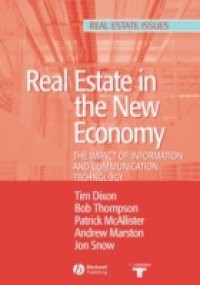Private sector commercial property represents some 400 bn, or 34% of total UK business assets and is a vital fabric for housing commercial enterprise. Yet social and economic forces for change, linked with new technology, are making owners and occupiers question the very nature and purpose of property and real estate. Printing, steam power; canals and railroads; mass media and, more recently, information and communications technology (ICT) have brought about major changes in both organisational and economic structures over the centuries. On the one hand, there has been much hype about the role that ICT would play in eliminating the need for physical real estate space; and on the other, some have suggested that institutional factors and fixed costs mitigate against transformative change in real estate. Building on the authors' own research and a growing body of new, international findings in the field, the book provides a balanced view between these two positions. It will demonstrate how ICT affects the shape and form of real estate in our towns and cities, with other forces in the new economy. The book: examines how ICT and organisational change, combined with social, political and economic factors, affects real estate space demand analyses how real estate strategies are changing to reflect these trends shows how technology affects the geography and space of real estate and infrastructure in our towns and cities investigates future urban shape and form.

